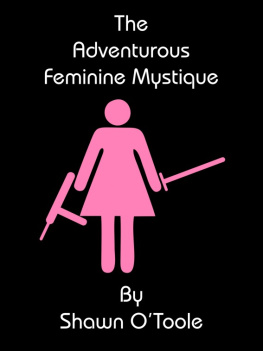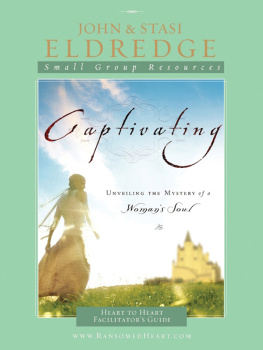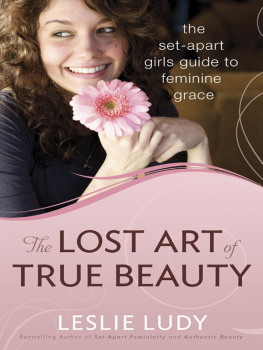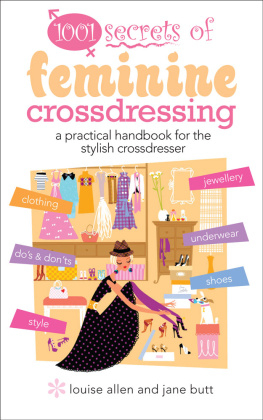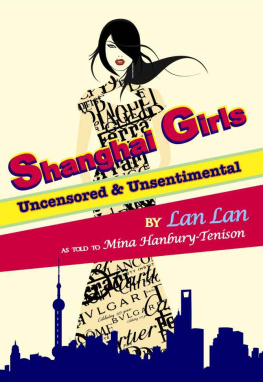THE ADVENTUROUS FEMININE MYSTIQUE
by
Shawn OToole
SMASHWORDS EDITION
*****
PUBLISHED BY:
Shawn OToole on Smashwords
Cover Art Illustrated by:
Shawn OToole
The Adventurous Feminine Mystique
Copyright Shawn OToole 2014
Without limiting the rights under copyright reservedabove, no part of this publication may be reproduced, stored, orintroduced into a retrieval system, or transmitted, in any form, orby any means (electronic, mechanical, photocopying, or otherwise)without the prior written permission of both the copyright ownerand the publisher of this story, except in the case of briefquotations embodied in critical articles and reviews.
Your support and respect for the property of thisauthor is much appreciated.
This is a work of nonfiction concerning the role andcreation of fictional characters. Even the historical figurementioned is mentioned as a fictional character of popularlegend.
*****
The Adventurous Feminine Mystique
*****
When a figment is fashioned in the likenessof a person we imagine it to be an entity. It assumes the qualitiesof the living yet it does not exist. It is an entity that isactually a nonentity contrived to suit us. It is but a player inour waking dreams.
A good character in any genre is one with amotive and a personality. These particulars need not be overtlystated but they must be demonstrated, somehow, or else thefictional persona is flat. Even a character of many should somehowpossess an identity all its own. People can only relate to people.No one can relate to a fictional element that is impersonal evenif it supposedly a character. Only a personality can be imagined tobe a person. The best characters are always individuals but evenin reality, there are types of individual. Characters are notdiminished by having a role to play: they have no place if theyhave no part.
There are eight generalizations of distincttypes of female character in adventure fiction. The same charactermay differ in type if she plays a different role in a differentscenario. Regardless, the types themselves are the rolesthemselves. The archetypes are
Protagonists
* Damsel in Distress: the helplessbeauty in need of rescue.
* Heroine: a courageous woman ofuncanny prowess who fights the good fight.
* Wise Woman: the maternal, imploringvoice of insight.
Antagonists
* Villainous Dominatrix: a boss whoasserts her authority by means of intimidation.
* Seductress: one who easily enticesothers to her will.
* Hag: a feminine monster of hideousaspect.
* Elite Henchwoman: an underling offormidable prowess.
* Useless Henchwoman: plentiful andexpendable underling.
Female characters are most often shallowextensions of male fantasy. The girl is either a bimbo or aninhuman dominatrix. By conscientious effort she may even befashioned to appease the touted feminist ideal. Yes, fiction isunreal by definition but it need not be dishonest.
Feminist indignation rails against thenatural heterosexual dynamic. Misogyny dehumanizes our verymothers, sisters and daughters. Unrefined masculinity is lewd,mindless and restless. Reject all such stupidity. Appreciate thefeminine for its grace and intuition. Be mindful that all people,male or female, have their individual thoughts and feelings.Understand that sensuality is sexier than vulgarity. Be eloquentrather than crude. Strive for as much as you can with as little asyou may. Cleanse your designs of the extraneous.
The Damsel in Distress is perhaps theoldest and most common role for female characters in adventurefiction. She is to be beautiful, innocent and desirable. Her rescueby a virile male typically ensures that she is to bear hisoffspring. Her purpose in the story is to motivate the hero tocourageous action. She is the catalyst for his ultimate glory.
The Heroine is traditionally rare buthas always been with us. She represents feminine courage anddedication. The Villainous Dominatrix is her antagonistcounterpart and represents passion and obsession.
The Wise Woman is traditionally avenerable crone whose uncanny insight enlightens the hero. She neednot be old but she must somehow prove maternal. She is the tellerof secrets, the voice of reason and the reminder of purpose.
The Seductress is the oldest role offemale villainy. She traditionally tests the inner strength of ahero by luring him to his doom by his own lusts. She is most oftenmore dangerous a foe than any warrior or monster.
The Hag is a female antagonist as amonster. She may be a duality that can assume the role ofSeductress at will: using a comely guise to lure the hero tohis doom. She may be a malevolent Wise Woman who misleads bymeans of subjective omens. She may simply be a brute monster whohappens to be female. Regardless, her true nature is alwaysmonstrous.
The Elite Henchwoman is a very raretype and more contemporary than traditional. She is simply thedangerous thug as a female. She may exhibit traits ofSeductress or even Hag but not to the degree that shecan truly assume their roles.
The Useless Henchwoman is the obscurefemale version of the common henchman: she is the plentiful,expendable underling of villainy. While on guard duty she is easilysnatched unawares. In combat her throngs wither en masse. Armed anduniformed she is a sheep in wolfs clothing. She differs from hermale peer in that she is at her best when comely. Her role is tothrill by arousing guiltless yet morbid, sensual amusement.
Narrative Context
An adventure story is meant to be excitingorit is not an adventure story. Conflict and sensuality arethe strongest spices of the genre. Violence in the context of goodagainst evil is a must. Even an antihero should prove sympatheticand somehow justified. Anything contrary to the triumph of goodagainst evil shall inevitably prove shallow and dreary. Theviolence in such a story is left meaningless. As for sexuality, itneed not be overt but its absence shall be a lack in theluster.
Aggression and sensuality are intense andsexual: no adventure story can be completely satisfying withoutthem. That said, the violence need not be gory nor the sexualitylewd. It is the danger and desperation that makes a fight intense.It is the exceptional prowess of heroes that makes them heroic. Itis the grim finality of death that captures our morbid interest.Comeliness is most comely when natural and unassuming. Drama andcontext shall always be fictional sex and violence at theirfinest.
An adventure story, like any other tale, isat its best when its characters are its most interesting aspect. Itis through the fictional people that we of reality experience thenarrative as if it is a reality.
* Damsel in Distress: Though alongstanding archetype in myth and legend and a mainstay ofadventure fiction, she is now decried as demeaning to women. Soas to reconcile her role with contemporary social agendas she isoften made a Heroine in captivity. PrincessLeia (Star Wars: a New Hope) is an excellent exampleof this modern manifestation of the character. Andromeda ofGreek Mythology sets the standard for the traditionalalternative.
Small minds fail to realize that a characterneed not be formidable to be interesting. Why should the Damselin Distress be a warrior? Heroines fight. Why must everyfemale protagonist be a Heroine? What if the fair damsel isan intellectual, a scientist, a scholar, a healer, a seer or theprincess of a peaceful kingdom? Good has its champions but itswarriors protect and avenge the gentle. Do not presume to make yourfair damsel a warrior lightly. Consider the countless, colorfulalternatives. Most people are helpless against powerful evils. Donot shun the
Next page
